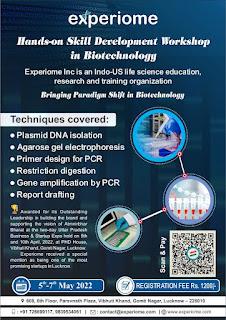Biotech Training And Research Centre In Lucknow | Experiome
Use of Genetically Engineered Cyanobacteria in Therapeutics
Spirulina
is a blue-green algae or cyanobacteria which is found in high-salt alkaline
water, subtropical and tropical places such as America, Mexico, Asia, and
Central Africa. It’s asexual
reproduction reduces the danger of gene escape into the food chain, as well as
the accompanying food security and regulatory concerns. It contains a lot of
macro and micronutrients, important amino acids, proteins, lipids, vitamins,
minerals, and antioxidants. With these characteristics, photosynthetic
cyanobacteria have been used in a variety of industries, including food,
health, and pharmaceuticals. It is consumed mainly in central Africa and later
NASA started using spirulina as a nutritional supplement for astronauts on
space missions. It gained attention for therapeutic benefits like
hypercholesterolemia, hyperglycerolemia, cardiovascular diseases, inflammatory
diseases, allergies, cancer and viral infections.
Spirulina,
as a plant-based biopharmaceutical, has the potential to overcome the
constraints and limits of existing crop-and algal-based platforms.
Modern
biotechnology focuses on genetic engineering to domesticate cells as biological
factories, which often comprises E.coli, yeasts, plant cells, and mammalian
cells.The availability of methods for genetic manipulation of the organism is
to achieve stable, high expression of exogenous proteins, as well as whether
the organism possesses biological traits compatible with large-scale manufacturing
and commercialization, are factors in deciding whether to switch to new
expression platforms or not. Genetically engineered plants, on the other hand,
have performance characteristics that were not deemed to be promising, such as
poor growth rates, low product yields, and regulatory limitations. This prompted
scientists to focus on something new: algae, which are an alternative to plants
but are difficult to manipulate since exogenous protein production levels are
low and often unstable. There hasn't been much research into the therapeutic
usage of algae.
Spirulina
has recently been genetically altered to produce high levels of therapeutic
proteins such as single-chain antibodies, enzymes, signalling proteins, vaccine
antigens, and bioactive peptides, as well as large-scale, indoor culture and
downstream processing technologies. When encapsulated within dried spirulina,
this targeted integration requires no purification prior to oral distribution,
is stable without refrigeration, and is protected during stomach transit. Oral
administration of a spirulina-expressed antibody that targets campylobacter, a
gramme negative bacteria that causes diarrhoea in humans and is a leading cause
of infant death in impoverished countries. This approach prevents disease in
mice, and a phase 1 clinical trial showed that it is safe to use in humans.
The
use of Cyanobacteria is useful to mankind, and it will soon be employed to heal
ailments that cause mortality.

Comments
Post a Comment